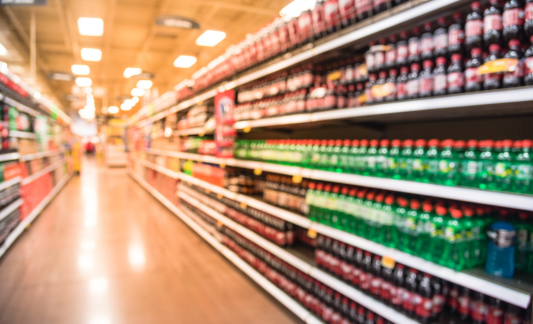Help Isom IGA recover from devasting floods

4 min read
Weight Loss Drugs Will Transform Grocery – Are Independents Ready?
Written by John Ross
May 9, 2024
Imagine that you are not in the grocery business at all, but you were in the eyeglass manufacturing industry. Now imagine that a pharmaceutical company just announced they had a drug that would reduce the need for corrective vision, perhaps by as much as a third. Imagine that the drug was in early rollout now, but that it was predicted to eventually be the largest single drug (in revenue dollars) ever produced, predicted to one day be bigger than the entire eyeglass and ophthalmology industries put together.
As an owner of eyeglass retail stores and manufacturing plants, you would have to pay attention to that, right?
Ok, back to grocery. Something similar is happening with the new class of drugs called Glucagon-Like Peptide-1 (GLP-1) Receptor Agonists, which are used in the treatment of type 2 diabetes and obesity. These drugs work by inhibiting glucagon production if blood sugar levels are high, and can delay gastric emptying, all of which promotes weight loss.
They also reduce body weight, sometimes significantly. Patients on these drugs lose between 8-15% of their body weight, often within three to twelve months.
While originally designed for the treatment of type 2 diabetes, they are increasingly being prescribed as a solution for weight loss – so much so that the Department of Health and Social Care issued a national patient safety alert for GLP-1 RAs, stating that the shortage is from increased demand for licensed and off-label brands.
Right now, only a few million Americans are on these GLP-1 medications, but prescriptions are growing fast. It is predicted to reach $50 billion in sales in 2024 and surpass $100 billion by 2029. That would make it almost as big as the entire U.S. food industry combined.
With 40% of Americans considered obese, according to the CDC, you can see why the pharmaceutical companies are rolling out GLP-1 drugs at an unprecedented rate.
As in my hypothetical eyeglass example above, we in the grocery industry should take pause. Within ten years there could be a drug prescribed to over a third of Americans, which in turn could cut food consumption significantly.
Today these drugs are expensive and difficult to acquire, even with insurance, due to the supply issues. But lawmakers are pushing manufacturers to lower the costs and the supply is expected to recover by the end of 2024.
The Impact On The Food Industry
What does it mean that within 10 years, a third of Americans could be eating nearly 20% less than they do today? What should we be doing now to adjust our business to anticipate should a radial impact on the industry?
First, we need to understand that health-focus is back to being a major American priority. During COVID, shoppers returned to ‘comfort’ brands, including high sugar cereals and sodas, and favorite snacking brands. Apparently when the world got scary, shoppers decided to favor taste and experience over health.
Post-COVID, we see a return to health-focused eating. Consumer demand for high protein and low-carb lifestyles continues. And patients using GLP-1 drugs must adopt a high protein, high fiber diet to combat muscle loss and constipation, two major side effects of these drugs. The majority of shoppers say they want to eat healthier foods, lose weight, get into better shape, whether they’re on these drugs or not.
Second, we need to understand that consumer wish and actual behavior are different. Financial barriers to healthy eating and a lack of nutritional education are very real concerns, and independent grocers must not only communicate but show shoppers what healthy eating looks like and that does not mean hefty spending.
Third, realize that eating at home is one of the simplest models for improving family health – and reducing costs. When you duplicate common restaurant meals with the same items cooked at home, you find that sodium is a third less, calories are often half per serving, and it tastes better. Plus the cost per serving is about a third.
Cooking at home with fresh meat and produce is often the best path toward reducing sodium and sugar in your bloodstream, and it reduces the likelihood and effects of chronic heart disease, diabetes, hypertension, and more.
So in a world where most of our shoppers are overweight, and the vast majority wish they had help getting on track; where replacing restaurant or take-out meals with the exact same meal cooked at home would reduce calories more than a daily or weekly GLP-1 shot, it seems like we are positioned perfectly to partner with our shoppers on their healthy eating goals.
Helping Health-Focused Shoppers
But are we really? Walk the average store and look for help in making smarter choices. Look at our delis, filled with fried foods and high-calorie options. Though we stock lots of better-for-you products, it is often totally up to the consumer to figure out what is best to buy, and how to cook differently.
Now wipe the slate clean. Imagine you are building a brand-new grocery store from the ground up. Knowing the opportunity — and also knowing the risks of a drug that might make a third of Americans eat a significantly less food within a decade — how would we change the way our store looks and operates?
- Signage that calls out better-for-you foods
- Endcaps integrating healthy recipes
- Comparison signage that educates shoppers on lower sugar/lower sodium options between processed and fresh
- Calorie per serving comparison between grocery and restaurants
- Weekly healthy-eating club emails
- Prepared/ready-to-heat options with half the sugar and sodium as other options
- Weekly sales/discounts on better-for-you products
And how would we work with our suppliers differently? Certainly, we would issue a challenge to innovate around health, and in turn we would take on the challenge to help brands with healthier products get more attention.
To win, we need creative thinking now. We need to focus our collective industry IQ on helping shoppers achieve their goals. And we need to begin now, building the best offense against the restaurant industry and the best defense against the pharmaceutical industry.
A few tactics are just the components of a much bigger strategy – instead of thinking of our stores as “a place to buy food,” we begin to up-brand into “the best place to helps shoppers make smarter choice.” If we do it right now, we could become the best ally a shopper could ever have.
That sounds like a smart strategy no matter what the pharmaceutical companies choose to do.
You May Also Like
These Stories on From the Desk of
Dec 18, 2025 9:32:36 AM |
3 min read
Dec 10, 2025 4:57:50 PM |
1 min read


No Comments Yet
Let us know what you think